
Augustine of Hippo, also known as Saint Augustine, was a theologian, philosopher, and the bishop of Hippo Regius in Numidia, Roman North Africa. His writings influenced the development of Western philosophy and Western Christianity, and he is viewed as one of the most important Church Fathers of the Latin Church in the Patristic Period. His many important works include The City of God, On Christian Doctrine, and Confessions.
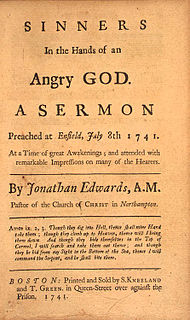
"Sinners in the Hands of an Angry God" is a sermon written by the American theologian Jonathan Edwards, preached to his own congregation in Northampton, Massachusetts, to profound effect, and again on July 8, 1741 in Enfield, Connecticut. The preaching of this sermon was the catalyst for the First Great Awakening. Like Edwards' other works, it combines vivid imagery of Hell with observations of the world and citations of Biblical scripture. It is Edwards' most famous written work, is a fitting representation of his preaching style, and is widely studied by Christians and historians, providing a glimpse into the theology of the First Great Awakening of c. 1730–1755.

The Sermon on the Mount is a collection of sayings and teachings attributed to Jesus Christ, which emphasizes his moral teaching found in the Gospel of Matthew.
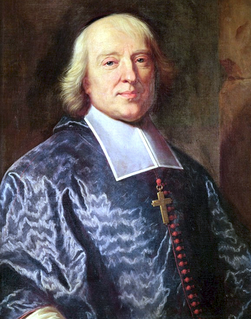
Jacques-Bénigne Lignel Bossuet was a French bishop and theologian, renowned for his sermons and other addresses. He has been considered by many to be one of the most brilliant orators of all time and a masterly French stylist.

John Colet was an English Catholic priest and educational pioneer.

A sermon is an oration or lecture by a preacher. Sermons address a scriptural, theological, or moral topic, usually expounding on a type of belief, law, or behavior within both past and present contexts. Elements of the sermon often include exposition, exhortation, and practical application. The act of delivering a sermon is called preaching. In secular usage, the word sermon may refer, often disparagingly, to a lecture on morals.

A surah is the equivalent of "chapter" in the Quran. There are 114 surahs in the Quran, each divided into ayahs (verses). The chapters or surahs are of unequal length; the shortest surah (Al-Kawthar) has only three verses while the longest (Al-Baqara) contains 286 verses. Of the 114 chapters in the Quran, 86 are classified as Meccan, while 28 are Medinan. This classification is only approximate in regard to the location of revelation; any chapter revealed after migration of Muhammad to Medina (Hijrah) is termed Medinan and any revealed before that event is termed Meccan. The Meccan chapters generally deal with faith and scenes of the Hereafter while the Medinan chapters are more concerned with organizing the social life of the nascent Muslim community and leading Muslims to the goal of Dar al-Islam by showing strength towards the unbelievers. Except for surahAt-Tawbah, all chapters or surahs commence with "In the Name of Allah, Ar-Rahman, Ar-Rahim ". This formula is known as the Bismillah and denotes the boundaries between chapters. The chapters are arranged roughly in order of descending size; therefore the arrangement of the Quran is neither chronological nor thematic. Surahs (chapters) are recited during the standing portions (Qiyam) of Muslim prayers. SurahAl-Fatiha, the first chapter of the Quran, is recited in every unit of prayer and some units of prayer also involve recitation of all or part of any other surah.
Expository preaching, also known as expositional preaching, is a form of preaching that details the meaning of a particular text or passage of Scripture. It explains what the Bible means by what it says. Exegesis is technical and grammatical exposition, a careful drawing out of the exact meaning of a passage in its original context. While the term exposition could be used in connection with any verbal informative teaching on any subject, the term is also used in relation to Bible preaching and teaching. The practice originated from the Jewish tradition of the rabbi giving a "Dvar Torah", explaining a passage from the Torah, during the prayer services. Expository preaching differs from topical preaching in that the former concentrates on a specific text and discusses topics covered therein; whereas, the latter concentrates on a specific topic and references texts covering the topic.

Biblical criticism is the use of critical analysis to understand and explain the Bible. During the eighteenth century, when it began as historical-biblical criticism, it was based on two distinguishing characteristics: (1) the scientific concern to avoid dogma and bias by applying a neutral, non-sectarian, reason-based judgment to the study of the Bible, and (2) the belief that the reconstruction of the historical events behind the texts, as well as the history of how the texts themselves developed, would lead to a correct understanding of the Bible. This sets it apart from earlier, pre-critical methods; from the anti-critical methods of those who oppose criticism-based study; from later post-critical orientation, and from the many different types of criticism which biblical criticism transformed into in the late twentieth and early twenty-first centuries.
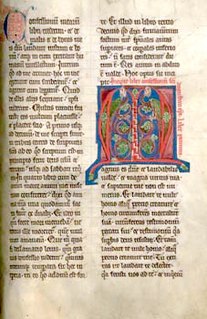
Confessions is an autobiographical work by Saint Augustine of Hippo, consisting of 13 books written in Latin between AD 397 and 400. The work outlines Saint Augustine's sinful youth and his conversion to Christianity. Modern English translations of it are sometimes published under the title The Confessions of Saint Augustine in order to distinguish the book from other books with similar titles. Its original title was Confessions in Thirteen Books, and it was composed to be read out loud with each book being a complete unit.

Homiletics , in religion, is the application of the general principles of rhetoric to the specific art of public preaching. One who practices or studies homiletics may be called a homilist, or more simply a preacher.

Caesarius of Arles, sometimes called "of Chalon" from his birthplace Chalon-sur-Saône, was the foremost ecclesiastic of his generation in Merovingian Gaul. Caesarius is considered to be of the last generation of church leaders of Gaul that worked to promote large-scale ascetic elements into the Western Christian tradition. William E. Klingshirn's study of Caesarius depicts Caesarius as having the reputation of a "popular preacher of great fervour and enduring influence". Among those who exercised the greatest influence on Caesarius were Augustine of Hippo, Julianus Pomerius, and John Cassian.
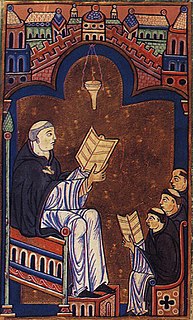
Hugh of Saint Victor, was a Saxon canon regular and a leading theologian and writer on mystical theology.

Matthew 5:1 and Matthew 5:2 are the first two verses of the fifth chapter of the Gospel of Matthew in the New Testament. The verses introduce the Sermon on the Mount that will be recited in the next several chapters. The previous verse mentioned the large crowds "from Galilee, and from the Decapolis, Jerusalem, Judea, and beyond the Jordan" who followed Jesus to witness him healing: these verses present Jesus as seeing the crowds and going up onto a mountain to begin teaching.

Matthew 5:10 is the tenth verse of the fifth chapter of the Gospel of Matthew in the New Testament. It is the eighth verse of the Sermon on the Mount, and also eighth, and to some the last, of what are known as the Beatitudes.
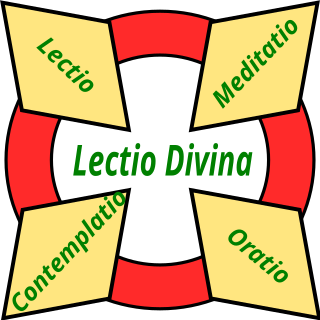
In Western Christianity, Lectio Divina is a traditional monastic practice of scriptural reading, meditation and prayer intended to promote communion with God and to increase the knowledge of God's word. In the view of one commentator, it does not treat scripture as texts to be studied, but as the living word.

Matthew 7:12 is the twelfth verse of the seventh chapter of the Gospel of Matthew in the New Testament and is part of the Sermon on the Mount. This well known verse presents what has become known as the Golden Rule.

De doctrina Christiana is a theological text written by Augustine of Hippo. It consists of four books that describe how to interpret and teach the Scriptures. The first three of these books were published in 397 and the fourth added in 426. By writing this text, Augustine set three tasks for Christian teachers and preachers: to discover the truth in the contents of the Scriptures, to teach the truth from the Scriptures, and to defend scriptural truth when it was attacked.
Ecclesiastes: On the Art of Preaching was a 1535 book by Desiderius Erasmus. One of the last major works he produced, Ecclesiastes focuses on the subject of effective preaching. Previously, Erasmus had written treatises on the Christian layperson, Christian prince, and Christian educator. Friends and admirers, including Bishop John Fisher suggested that Erasmus write on the office of the Christian priesthood. He began writing the text in 1523, finally completing and printing Ecclesiastes in 1535.
Over the last few decades in the United States, some homiletical theorists and preachers have questioned the hegemony of the traditional rhetorical approaches to preaching. Many alternative styles and approaches have been developed, many of which are called "narrative" in either style or content.